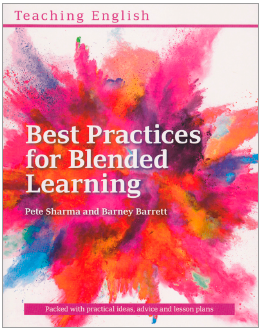Best Practices for Blended Learning by Pete Sharma and Barney Barrett

In this book, Pete Sharma and Barney Barrett have attempted to address the challenges that institutions and practitioners face when trying to implement a blended learning (BL) course. The pair recognise that one of the core issues at the heart of the BL approach is the absence of definitive rules when it comes to its effective implementation. As a result, teachers and institutions can be quickly overwhelmed by the sheer number of approaches and potential methodologies that exist. There is little doubt that there is an established need for a book that attempts to pull all these issues together and offer concise and informed guidance for those looking to set up a BL course.
The book is split into three sections, the first opening with an overview of what exactly is meant by the term blended learning. From there, the book presents a practical framework for those wishing to set up a BL course, as well as describing the main platforms available. The second section is more practical, as Sharma and Barrett introduce 20 practical ideas for BL, which cover everything from grammar and vocabulary to assessment. Finally, the third section looks at the future of BL and gives some tips for teacher training, before including some photocopiable material.
One of the most useful aspects of the book, for those new to the concept of BL, is the way in which it explains key terms, particularly the main models employed on a BL course. The ‘%’ model refers to the percentage of the course which is supported by online work. For example, on a 70–30 course, 30% of the learning is done online. This can increase to a hybrid course (50–50) or up to 100% on an online course. Implementing a ‘dual track’ approach means that students have 24/7 online access to the online materials that supplement their taught classroom materials. These materials may or may not be related to each other, but both have a similarly holistic learning aim. Arguably, the most well-known model is the ‘flipped classroom’ approach, where the online learning materials are introduced before the lesson starts, and are then utilised in the classroom, with the focus being on deepening understanding of what has been studied before the lesson.
Sharma and Barrett understand that there are various challenges facing institutions who wish to set up a BL course, and they deal with each of them in turn. They identify the fact that employing a successful blended learning component takes a great deal of time and effort, and also acknowledge other considerations that need to be taken into account, such as appropriacy and the need for training for teachers and students alike. Their framework for creating a BL course is very useful, as it allows practitioners and institutions to work systematically through four clear stages that the authors believe will help to create a successful BL course.
Where the book really excels is in the easily digestible overviews of the various platforms available. From publisher-produced platforms to learning management systems, such as Blackboard and Moodle, to Google Classroom, each one is explained in detail with a summary of their fundamental advantages and disadvantages. Coupled with individual case studies, these chapters in the book allow the reader to reach an informed decision about which platform would work best in their situation.
The practical ideas that make up the second section are useful for those who want ideas to use with learning management systems. However, those looking for activities that they can pick out and use instantly may be a little disappointed. Many of these activities ask for an awful lot of commitment, often far beyond what can reasonably be expected of a busy teacher. For instance, ideas such as recording screencasts or sending emails of sentences to practise at home all involve quite a lot of preparation and continual monitoring.
There is a telling part in the ‘Tips for teacher trainers’ chapter towards the end of the book that proves this point. When discussing a comment from an attendee at a training session who questioned the usefulness of the activities as they wouldn’t have time to implement them, Sharma and Barrett interpret this as more of a reflection of the limitations of that teacher’s circumstances rather than any failing in the training. However, taken more objectively, the comment identifies an inherent problem with the BL approach as a whole: it is more applicable to higher education establishments with the time, money and inclination to implement it, and many activities are simply impractical for teachers working in language schools, as they would take too much time to set up and monitor. Those who advocate BL need to recognise the work pressures and time constraints on the majority of teachers working in secondary education and language schools.
I believe that, used correctly and effectively, a BL approach certainly has a place in the ELT sector and, for certain institutions, BL platforms afford a range of fresh and innovative teaching opportunities. That said, this book is a good introduction to the difficult topic of blended learning.
Paul Carr Exeter, UK
Comments
Write a Comment
Comment Submitted